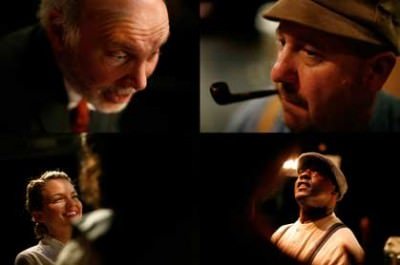Street Scene

National Pastime Theater
in conjunction with Clock Productions
Street Scene
By: Elmer Rice
Directed by: Laurence Bryan and Keely Haddad-Null
At National Pastime Theater
Rare Revival of Street Scene .
I always find it exciting when a company decides to do a play that is well written, but rarely seen. I also applaud companies for taking risks in form and style rather than sticking to realism. However, it is always a difficult task to combine the two pieces together. In association with Clock Productions, National Pastime Theater’s revival of Elmer Rice’s 1929 Pulitzer Prize winning play is unable to combine both the eighty year old script with modern theatrical technique into a cohesive evening of theatre.
The play is set in 1929, just before the stock-market crash, as the tenants of a New York tenement house try to get through the simple struggles of everyday life. For those unfamiliar with Elmer Rice (who has a surprisingly large body of work), his play is similar in tone to that of Clifford Odets and exceedingly realistic. At first glance the production is a traditional ensemble drama, but it deviates into moments of the grotesque. When I say grotesque I do not mean disgusting or revolting, but rather the movement of theatre started by Italian dramatists in the early 1900s that is against realism. It is often attributed as being the precursor to Theatre of the Absurd. This is where the main problem lies in the production; the combination of two forms that are completely in opposition of one another. The grotesque moments make the realistic moments feel flat and fake, and the realistic moments make the grotesque moments feel out of place and unmotivated (unless you count the flashing red light that indicates the arrival of a new grotesque moment). Furthermore, the jazz choreography of the grotesque moments is not very inventive, engaging, visually stimulating. I have seen realistic plays done very successfully in an avant garde production, but this was because they fully embraced the absurdity or grotesqueness of the world. It is not a matter of which style is right or wrong, it is a matter of consistency. This production is constantly in conflict with itself, so it is never able to go anywhere.
The other major problem with the show is the dialect work. When I say this I do not want to fault the dialect coach, Jason K. Martin. He was faced with a monumental task by having to coach various accents for a cast of 23. Many of these accents (ranging from New York, Jewish, Eastern European, Irish, etc…) are not easy to learn. However, the success of the accent varies by cast member. Many actors would drop in and out of their accents, and some accents border on caricature. For example, the “main” family of focus, The Maurrants, all have thick New York accents with the exception of the older daughter Rose. The scenes became more about the actors trying to get their accents correct than about the emotional connection to the story, and since the characters are not connected it is difficult for the audience to feel connected. Although the performances are not stellar, it is hard to fault the actors completely for having to juggle accents, conflicting styles, and a very rude audience (I plead with all audience members to never take pictures during a play. It is one of the rudest things you can do because it is distracting to the actors on stage and the audience in their seats.).
What I most applaud is the scenic design of David Denman, who has taken the small storefront space and placed a two story New York Tenement house inside. The two story set is complete with windows, doors, and makes a stronger visual statement than any of the grotesque movement moments. The lighting design is well done, but feels underwhelming because the in the grotesque moments the lights simply shift to a darker tone. This happens repeatedly and without variation.
As I said before, I applaud National Pastime and Clock Productions for taking risks and doing a rarely seen work in a rarely seen style. However, this production is an incoherent mess caused by conflicting theatrical styles. This results in two-dimensional characters with two-dimensional relationships and confusion for the audience. My hope is that National Pastime continues to take risks in their work, as long as they are more careful with how they experiment in the future.
Not Recommended
Jake Lindquist
At The National Pastime Theater, 4139 N. Broadway Ave., Chicago. Tickets $25 (Thursdays 2 for 1)
